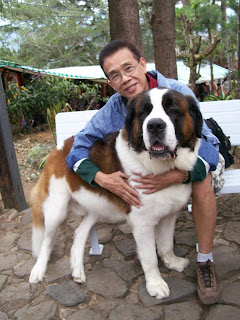
Every once in a while, you got that chance to have your big smile caught on a camera together with a dog who is also willing to share a nice grin! This is one of those rare moments! Anong say niyo?
About St. Bernard Dogs
Original Author: Robert Leighton
The history of the St. Bernard dog would not be complete without reference being made to the noble work that he has done in Switzerland, his native land: how the Hospice St. Bernard kept a considerable number of dogs which were trained to go over the mountains with small barrels round their necks, containing restoratives, in the event of their coming across any poor travellers who had either lost their way, or had been overcome by the cold.
We have been told that the intelligent animals saved many lives in this way, the subjects of their deliverance often being found entirely buried in the snow.
The following is the description of the St. Bernard as drawn up by the members of the St. Bernard Club:
HEAD--The head should be large and massive, the circumference of the skull being more than double the length of the head from nose to occiput. From stop to tip of nose should be moderately short; full below the eye and square at the muzzle; there should be great depth from the eye to the lower jaw, and the lips should be deep throughout, but not too pendulous. From the nose to the stop should be straight, and the stop abrupt and well defined. The skull should be broad and rounded at the top, but not domed, with somewhat prominent brow.
EARS--The ears should be of medium size, lying close to the cheek, but strong at the base and not heavily feathered.
EYES--The eyes should be rather small and deep set, dark in colour and not too close together; the lower eyelid should droop, so as to show a fair amount of haw.
NOSE--The nose should be large and black, with well developed nostrils. The teeth should be level.
EXPRESSION--The expression should betoken benevolence, dignity, and intelligence.
NECK--The neck should be lengthy, muscular, and slightly arched, with dewlap developed, and the shoulders broad and sloping, well up at the withers.
GENERAL DESCRIPTION OF BODY--The chest should be wide and deep, and the back level as far as the haunches, slightly arched over the loins; the ribs should be well rounded and carried well back; the loin wide and very muscular.
TAIL--The tail should be set on rather high, long, and in the long-coated variety bushy; carried low when in repose, and when excited or in motion slightly above the line of the back.
LEGS--The fore-legs should be perfectly straight, strong in bone, and of good length; and the hind-legs very muscular. The feet large, compact, with well-arched toes.
SIZE--A dog should be at least 30 inches in height at the shoulder, and a bitch 27 inches (the taller the better, provided the symmetry is maintained); thoroughly well proportioned, and of great substance. The general outline should suggest great power and capability of endurance.
COAT--In the long-coated variety the coat should be dense and flat; rather fuller round the neck; the thighs feathered but not too heavily. In the short-coated variety, the coat should be dense, hard, flat, and short, slightly feathered on thighs and tail.
COLOUR AND MARKINGS--The colour should be red, orange, various shades of brindle (the richer colour the better), or white with patches on body of one of the above named colours. The markings should be as follows; white muzzle, white blaze up face, white collar round neck; white chest, forelegs, feet, and end of tail; black shadings on face and ears. If the blaze be wide and runs through to the collar, a spot of the body colour on the top of the head is desirable.
The weight of a dog should be from 170 lbs. to 210 lbs.; of a bitch 160 lbs. to 190 lbs. More about St. Bernard..


















do you sell st.bernard puppies?
ReplyDelete